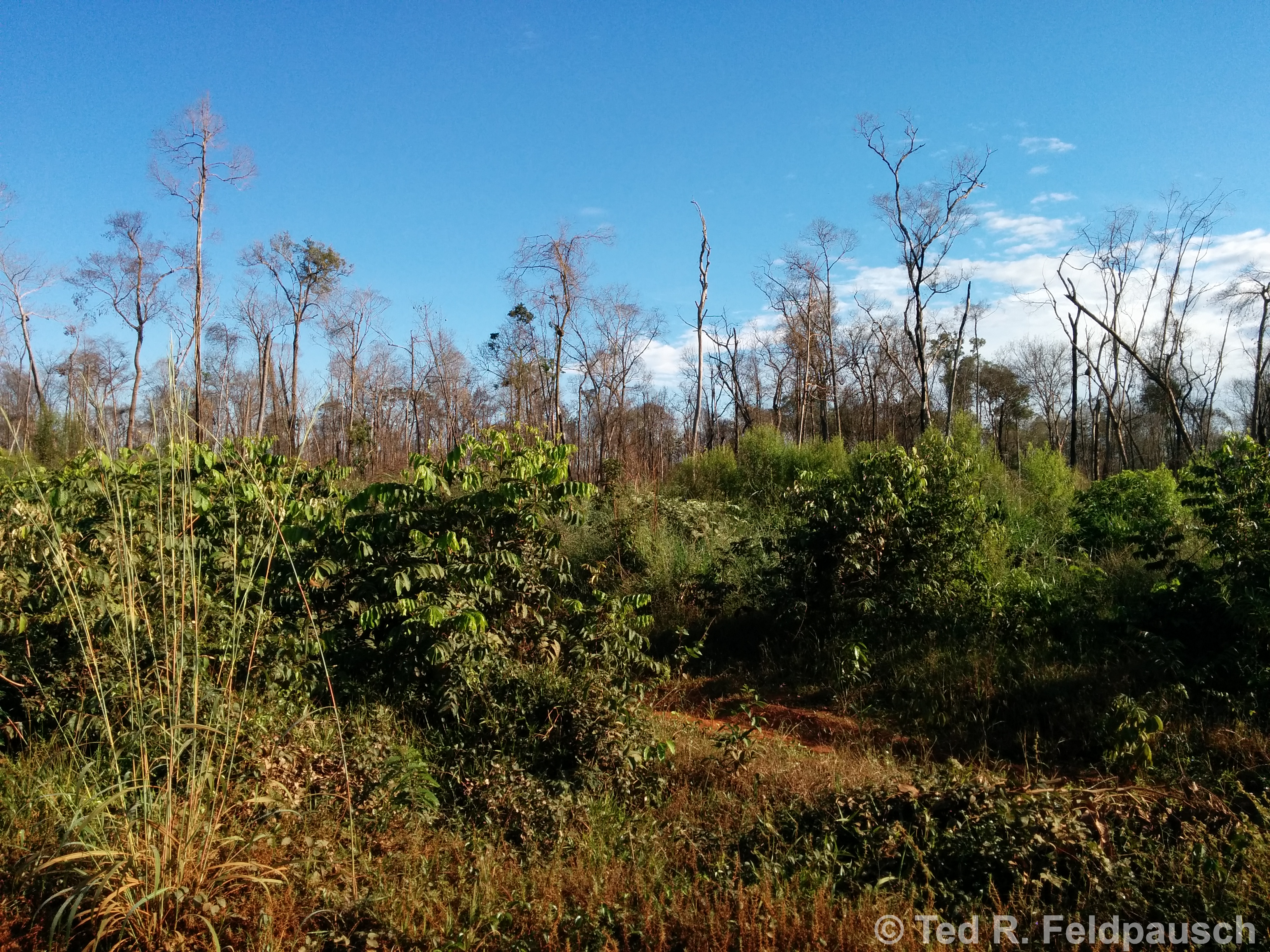
Posted by Ted Feldpausch
14 February 2020There has been a large increase in deforestation and wildfire in Amazonia over recent years. Fire in tropical forests increases tree mortality, degrades forest structure, and reduces carbon stocks (Figure 1). Remote sensing now permits a rapid and accurate assessment of the location and extent of fires. On the ground and in forests, however, there are significant challenges to estimating the actual effects of fire on forests across a region the size of Europe.
In particular, there are large gaps in understanding how fire affects understory forest structure and composition, interactions with fire recurrence, and long-term impacts. Understanding these changes is critical to evaluate the present and future response of tropical forests to fire. A new study led by our international team from the UK, Brazil, and USA studied post-fire changes in understory regeneration in forests in southern Amazonia, Brazil (above, a burned forest in southern Amazonia in Mato Grosso, Brazil; Photo credit: Ted R. Feldpausch.
The research included extensive fieldwork (Figure 1) to study how wildfire affects understory vegetation and how and over what time-scales forests recover. The work was led by researchers from the University of Exeter, Mato Grosso State University (UNEMAT), the US Forest Service, and the Brazilian Agricultural Research Corporation (Embrapa), comprising MSc research by Nayane Prestes and coordinated by Drs Ted Feldpausch, Michael Keller, Klecia Massi, Beatriz Marimon, and Ben Hur Marimon-Junior.


Figure 1. a) Study sites in southern Amazonia in Mato Grosso State, in the municipality of Feliz Natal, showing the distribution of nine study sites, with four plots per site. Sites were classified as “not-burned (T04, T05, and T06)”, “burned-1999 (T07, T08, and T09)”, “burned only once, in 2010 (T03),” and “Burned-3x (burned three times in 2006, 2010, and 2013) (T01 and T02)”. b) A forest damaged by wildfire in southern Amazonia, Mato Grosso State, Brazil (Photo credit: Ted R. Feldpausch).
The research aimed to answer the following questions: (i) does forest structure (basal area) and tree community composition vary with fire frequency and time since the last fire (Figure 2)? (ii) does the response differ among strata (e.g., sapling, larger trees)? (iii) are changes in diversity associated with changes in forest structure? We surveyed trees and lianas in previously structurally intact forests that underwent selective logging, followed by different fire histories, including 5 (B1-2010) and 16 years (B1-1999) after once-burned, 5 years after three times burned (B-3x), and unburned (NB, control).
Main findings
Overall, we found that fire had major impacts on forest composition and reduced forest diversity. Species composition (abundance, richness and number of families) and diversity were highest for the unburned treatment and lowest for the recurrent burned areas. Fire frequency negatively affected plant structure and basal area, with plants from the most frequently burned areas having a reduction of 50% or more in basal area compared to the unburned sites. Richness was positively related to basal area in the three times burned sites and in the sixteen years regenerating site for all strata, so that as basal area declined following fire diversity also declined.

Figure 2. Relationship in each stratum between richness and time since the last fire (years) for A-E seedlings to large trees and F all strata combined. Only curves that showed significant differences were plotted.

Figure 3. Basal area (m2 ha−1) in each stratum and according to fire regimes. Analyses were conducted separately for each vegetation strata (A) SE, (B) SP, (C) SML, (D) MT, (E) LT, and (F) for all strata together. LT stands for large trees, MT for medium trees, SML for small trees and woody lianas, SP for saplings, and SE for seedlings. The p-values indicate whether comparisons were statistically significant according to Kruskal–Wallis tests, and the lowercase letters above bars show differences among treatments. The line crossing bars indicate the median, the solid square denotes the mean, the boxes account for the 25th and 75th percentiles and vertical lines are the minimum and maximum values.
Broader implications
This study addresses one of the principal questions for forest management and conservation in Amazonia about how forests change following selective logging followed by single and repeat fire events and the degree to which forests can then regenerate and conserve biodiversity. Our results demonstrate the negative influence of frequent fires on both the composition and structure of small trees in Amazonian forest. These changes to the cohort of small-sized trees may persist and have long-term impacts on forest structure, affecting the capacity and direction of forest recovery, e.g., will forests become more savanna-like with recurrent burnings? With wildfire widespread across the region and increasing in frequency, fire may negatively affect tree diversity in remaining selectively logged forests and affect regional carbon cycling with consequences for the global vegetation carbon sink.




Figure 4: The international team conducting fieldwork and preparing plant samples for identification and archive at the UNEMAT herbarium to study post-fire effects on understory vegetation in southern Amazonia, Mato Grosso State, Brazil (Photo credit: Ted R. Feldpausch)
The work was supported by the Coordination of Improvement of Personnel in Higher Education, Brazil (CAPES) through a Science without Borders grant to TRF (PVE 177/2012) and NERC (NE/N011570/1). Fieldwork was supported by the Sustainable Landscapes Brazil Project operated by the USFS and EMBRAPA with financial support from USAID and US Department of State and a SilvaCarbon grant to MK and TRF. The National Council of Science and Technology, Brazil (CNPq) is acknowledged for a productivity grant (bolsa produtividade PQ) for BHMJ and BSM, for a Postdoctoral fellowship to DSN, and the financial support to the projects PELD (403725/2012-7) and PPBio (457602/2012-0).
Read the full study here: https://www.frontiersin.org/articles/10.3389/ffgc.2020.00010/abstract
Citation: Prestes NCCdS, Massi KG, Silva EA, Nogueira DS, de Oliveira EA, Freitag R, Marimon BS, Marimon-Junior BH, Keller M and Feldpausch TR (2020) Fire Effects on Understory Forest Regeneration in Southern Amazonia. Front. For. Glob. Change 3:10. doi: 10.3389/ffgc.2020.00010 (full text).
Text and Photos: Dr Ted R. Feldpausch